

Khallingse - Unit 13 Ancient Rome. Thinking Through History. Some days I know exactly what I want to post.
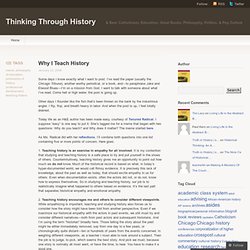
I’ve read the paper (usually the Chicago Tribune), another worthy periodical, or a book, and—to paraphrase Jake and Elwood Blues—I’m on a mission from God. I want to talk with someone about what I’ve read. Come hell or high water, the post is going up. Other days I flounder like the fish that’s been thrown on the bank by the industrious angler. I flip, flop, and breath heavy in labor. Today life as an H&E author has been made easy, courtesy of Tenured Radical.
Education. Mr. Hendricks's Global History Explorer: Oct 27, 2010. 1.

Do Now 5 MinutesPurpose: To create a common language between the teacher and the student. To ease communication. To get students thinking about the focus question.A) Directions: Save this SAG as Unit 2: Lesson 4, Focus: What Are the Most Significant Developments From the Mesopotamian Civilization? B) Directions: Answer the below question and prepare for a whole class discussion. What are important (significant) inventions that you believe people cannot live without? 3. Directions: Use the British Museum website to explore how best to answer the below guiding questions.a) Who developed the first type of writing? Medieval World History. Becoming Human: Series Overview. Becoming Human – Hour 2 PBS Airdate: November 10, 2009 NARRATOR: Humans: without a doubt, the smartest animal on Earth.
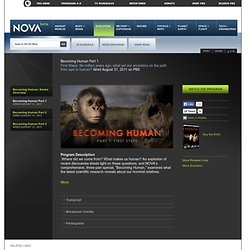
Yet we're unmistakably tied to our ape origins. Millions of years ago, we were apes, living ape lives in Africa. So how did we get from that to this? The questions are huge. At the threshold of humanity, one ancestor contains tantalizing secrets. RICHARD WRANGHAM (Harvard University): Homo erectus had a slightly smaller brain, slightly bigger jaw, but it's basically us.
Becoming Human. Introduction to Human Evolution. Human evolution Human evolution is the lengthy process of change by which people originated from apelike ancestors.
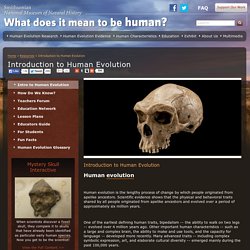
Scientific evidence shows that the physical and behavioral traits shared by all people originated from apelike ancestors and evolved over a period of approximately six million years. One of the earliest defining human traits, bipedalism -- the ability to walk on two legs -- evolved over 4 million years ago. Other important human characteristics -- such as a large and complex brain, the ability to make and use tools, and the capacity for language -- developed more recently.
Many advanced traits -- including complex symbolic expression, art, and elaborate cultural diversity -- emerged mainly during the past 100,000 years. Humans are primates. Most scientists currently recognize some 15 to 20 different species of early humans. Human Evolution. Summary of Findings Man has been a tribal animal since he first walked erect, more than four million years ago.

With the impediment of being bipedal, he could not out-climb or outrun his predators. Only through tribal cooperation could he hold his predators at bay. For two million years, the early hominid was a herd/tribal animal, primarily a herd herbivore. During the next two million years the human was a tribal hunter/warrior. The intellect, the magnitude of which separates the human from all other animals, developed slowly over the entire four million years or more of the human development. Background and Introduction The direct lineage from the ancestor of both man and the modern apes to modern man is not known. Early Hominin Evolution: Discovery of Early Hominids. Teaching materials. Teaching materials Evolution is essential to our curriculum and to scientific literacy.

Imagine teaching social science without teaching history; students would lack perspective on events going on today. Similarly, to understand the big picture of biology, students need to understand life on Earth in terms of its history and its future — the changing life forms and ecosystems that have arisen and changed over billions of years, as well as the mechanisms that have brought about those changes. The Understanding Evolution project aims to help instructors develop student understanding of: Human Evolution.
Geography. 10th Grade World History - Mr. Knoeckel's Social Studies Site! Global%2010%20Curriculum%20Writing%202012. WorldHistory_StandardAndHonors. Malaika Syphertt (WHist) at Booker T. Washington High School. 2013-2014%20Curriculum%20Map%20Grade%2010%20World%20History. Default. Welcome to 10th Grade Global History Present Unit of Study:Enjoy Your Summer!!!

World History Syllabus 10th Grade. 12-13 Social Science Grade 10 Wolrd History II Curriculum Guide.pdf. Helping Students Analyze Text: Teaching Strategies To Help Students Understanding. Social Studies Teacher Resources. Lesson Plans. Teacher Class Sites. Various State Standards Resources. SCORE History/Social Science: Virtual Projects & Field Trips. Browse through dozens of special online projects...
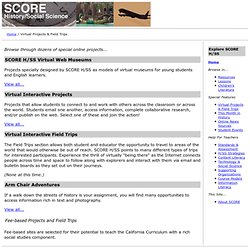
SCORE H/SS Virtual Web Museums Projects specially designed by SCORE H/SS as models of virtual museums for young students and English learners. View all... Virtual Interactive Projects Projects that allow students to connect to and work with others across the classroom or across the world. View all... Virtual Interactive Field Trips. SCORE History/Social Science: Standards & Assessment: Framework & Standards: By Grade.
U.S. History Open Textbook. Digital textbooks and standards-aligned educational resources. World History for Us All: Teaching Units. Home > This model curriculum groups instructional units into three categories.
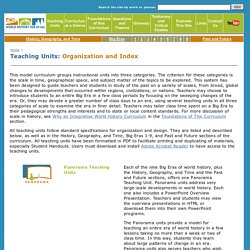
The criterion for these categories is the scale in time, geographical space, and subject matter of the topics to be explored. This system has been designed to guide teachers and students in study of the past on a variety of scales, from broad, global changes to developments that occurred within regions, civilizations, or nations.
Chapter 22: A Pedagogy for Teaching Social Studies - LLSS 315 Educating Linguistically Diverse Students. Chapter 22: Pedagogy to Teach Social Studies from a Global Perspective for English Language Learners American social studies are based on the concept of extending students social environments moving from self, to family, to community, to neighborhood, to nation and to the world.
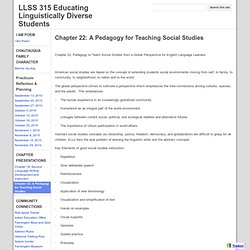
The global perspective strives to cultivate a perspective which emphasizes the inter-connections among cultures, species, and the planet.